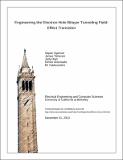Engineering the Electron-Hole Bilayer Tunneling Field-Effect Transistor
Author(s)
Agarwal, Sapan; Teherani, James T.; Hoyt, Judy L.; Antoniadis, Dimitri A.; Yablonovitch, Eli
DownloadAntoniadis_Engineering the.pdf (361.4Kb)
OPEN_ACCESS_POLICY
Open Access Policy
Creative Commons Attribution-Noncommercial-Share Alike
Terms of use
Metadata
Show full item recordAbstract
The electron-hole (EH) bilayer tunneling field-effect transistor promises to eliminate heavy-doping band tails enabling a smaller subthreshold swing voltage. Nevertheless, the electrostatics of a thin structure must be optimized for gate efficiency. We analyze the tradeoff between gate efficiency versus ON-state conductance to find the optimal device design. Once the EH bilayer is optimized for a given ON-state conductance, Si, Ge, and InAs all have similar gate efficiency, around 40%-50%. Unlike Si and Ge, only the InAs case allows a manageable work function difference for EH bilayer transistor operation.
Date issued
2014-04Department
Massachusetts Institute of Technology. Department of Electrical Engineering and Computer Science; Massachusetts Institute of Technology. Microsystems Technology LaboratoriesJournal
IEEE Transactions on Electron Devices
Publisher
Institute of Electrical and Electronics Engineers (IEEE)
Citation
Agarwal, Sapan, James T. Teherani, Judy L. Hoyt, Dimitri A. Antoniadis, and Eli Yablonovitch. “Engineering the Electron-Hole Bilayer Tunneling Field-Effect Transistor.” IEEE Transactions on Electron Devices 61, no. 5 (May 2014): 1599–1606.
Version: Author's final manuscript
ISSN
0018-9383
1557-9646